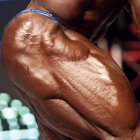 Q: I’ve been lifting consistently twice a week for the past few years and really want to step up my training. I’ve been training the whole body every workout. Got any suggestions?
Q: I’ve been lifting consistently twice a week for the past few years and really want to step up my training. I’ve been training the whole body every workout. Got any suggestions?
A: My first suggestion is to ditch the idea that you need to train your whole body at every workout—that approach doesn’t give enough attention to each major bodypart. For example, if you work your legs hard with hardcore exercises such as back squats, split squats and leg presses, you won’t have much energy left for your upper body.
Further, when you thoroughly thrash a bodypart with the exercise protocols I’m about to share with you, you’ll need more rest time to recover completely.
The following workout uses a two-days-on/one-day-off/one-day-on/one-day-off training split. That means you train two days in a row, rest a day, train one day, rest a day, and then start over. That gives you five days’ rest for each bodypart, and you train each area six times in a month. The intent is not to produce maximal increases in strength or decreases in bodyfat but to thrash the type 2A muscle fibers to create maximal muscle mass as quickly as possible. Here you go:
Day 1: Biceps, triceps
A1) Reverse EZ-curl bar Scott curls, 4/0/1/0 tempo,
5 x 4-6
Rest 120 seconds
A2) Triceps dips, 4/0/1/0 tempo, 5 x 4-6,
Rest 120 seconds
B1) Incline hammer curls, 3/0/1/0 tempo, 4 x 8-10
Rest 90 seconds
B2) Flat-bench dumbbell triceps extensions, 3/0/1/0 tempo, 4 x 8-10
Rest 90 seconds
C1) Low-pulley supinated-grip curls, 2/0/1/0 tempo,
3 x 12-15
Rest 60 seconds
C2) Low-pulley rope French presses, 2/0/1/0 tempo,
3 x 12-15
Rest 60 seconds
Note: Day 1 is designed to work all areas of the biceps’ strength curves. The first exercise overloads the start of the movement, the second the midrange and the third the end range. In contrast, programs that start with standing barbell curls and follow with standing dumbbell curls are not a productive use of time because both exercises emphasize the midrange of the biceps.
Day 2: Quadriceps, hamstrings and calves
A1) Front squats (heels elevated), 4/0/1/0 tempo, 5 x 4-6,
Rest 180 seconds
B1) Standing leg curls, 4/0/1/0 tempo, 4 x 6-8
Rest 90 seconds
B2) Dumbbell split squats (front foot elevated), 1 1/4 reps, 3/0/1/0 tempo, 4 x 6-8
Rest 90 seconds
C1) Stiff-legged deadlifts, 3/0/1/0 tempo, 3 x 10-12
Rest 90 seconds
C2) Wide-stance leg presses, 2/0/1/0 tempo, 3 x 15-20
Rest 90 seconds
D) Machine standing calf raises, 2/0/1/1 tempo, 3 x 10, 8, 6
Rest 90 seconds
Note: Front squats and leg curls are done for lower repetitions, both for different reasons. Whereas higher rep ranges are preferred in the back squat, most experts like to train the front squat in a lower rep range, and they frequently endorse doing singles in that lift. Performing more than six reps is not advisable because the scapulae retractors will not be able to maintain an upright posture during the exercise. For leg curls the reason is that the hamstrings are primarily composed of the faster type 2B fibers and respond better to lower reps.
Although I prefer supersets, here you perform front squats with the heels elevated by themselves and take 180 seconds’ rest between sets. That’s an extremely effective but difficult lower-body exercise, and I prefer that it be performed by itself with adequate rest time between sets to ensure complete recovery.
Day 3: Chest, back
A1) 45-degree incline dumbbell presses, 4/0/1/0 tempo, 5 x 4-6
Rest 120 seconds
A2) Wide-grip pullups, 3/0/1/0 tempo, 5 x 6-8
Rest 120 seconds
B1) Flat-barbell bench presses to neck, 3/0/1/0 tempo,
3 x 8-10
Rest 90 seconds
B2) Seated rows to waist, 3/0/1/1 tempo, 3 x 8-10
Rest 90 seconds
C1) Decline flyes, 3/0/1/0 tempo, 3 x 10-12
Rest 60 seconds
C2) Seated rope rows to neck, 3/0/1/0 tempo, 3 x 12-15
Rest 60 seconds
Note: You use a variety of angles with these chest exercises. My experience has shown that including a variety of angles is necessary to achieve maximum development. Each angle taps into a different motor unit pool and the variety produces less stress on the rotator cuff muscles.
For the upper back I’ve included one vertical-pulling and two horizontal-pulling exercises. The seated rope rows to neck are especially valuable; the upper-back muscles that pull the shoulders back are relatively weak in most trainees, especially those who focus on the bench press.
After a month of using this routine, your body will start reaching a point of diminishing returns, and you should move on to another workout. But be prepared: This workout obviously takes a serious time commitment, so make sure you’re serious about getting big.
Editor’s note: Charles Poliquin is recognized as one of the world’s most suc-cessful strength coaches, having coached Olympic med-alists in 12 different sports, including the U.S. women’s track-and-field team for the 2000 Olympics. He’s spent years researching European journals (he’s fluent in English, French and German) and speaking with other coaches and scientists in his quest to optimize training methods. For more on his books, seminars and methods, visit www.CharlesPoliquin.com. IM




















You must be logged in to post a comment Login